Classification of Waves (Advanced Concepts)
A wave is a temporary disturbance that transports energy in a given direction.
Mechanical waves travel only within a medium composed of matter, while electromagnetic waves travel in a vacuum.
Depending on whether the disturbance is perpendicular or parallel to the direction of the wave, it is categorized as transverse or longitudinal.
The table below categorizes several examples of waves according to their type. Click on the links in the table to learn more.
| Waves classified according to the propagation medium | |||
| Mechanical waves | Electromagnetic waves | ||
| Waves classified according to propagation direction | Transverse waves |
|
|
| Longitudinal waves |
|
Ø | |
Every wave belongs to more than one category. For example, radio waves are both electromagnetic and transverse.
Wave Classification According to Propagation Medium
Mechanical Waves
A mechanical wave propagates by displacing the particles that make up the medium.
When a mechanical wave passes, the position of the particles temporarily changes, forcing nearby particles to move, which in turn affects other nearby particles and so on. This is how energy is transported and a wave travels in a given direction.
Once the wave passes, the particles return to their original position. A mechanical wave therefore transports energy by temporarily moving the particles of a medium, without actually transporting the particles.
Swinging a jump rope is an example of a mechanical wave.
Rapidly swinging the end of a jump rope (the propagation medium) up and down forms a curve (a disturbance).
This curve propagates along the length of the rope allowing the wave to travel to the other end.
The temporary deformation of the rope transports energy and the rope returns to its initial position once the wave has passed. It is the wave and not the rope that transports the energy.
Mechanical wave in a jump rope
Sound is a mechanical wave.
When a sound wave passes, a vibration propagates between the particles of a medium.
For example, when a bird chirps, its vocal cords produce a temporary vibration (a disturbance) that propagates through the air (the propagation medium).
When these vibrations reach our ears, our eardrums vibrate, allowing us to perceive the sound.
Sound waves temporarily vibrate air particles to transport energy without transporting the air particles.
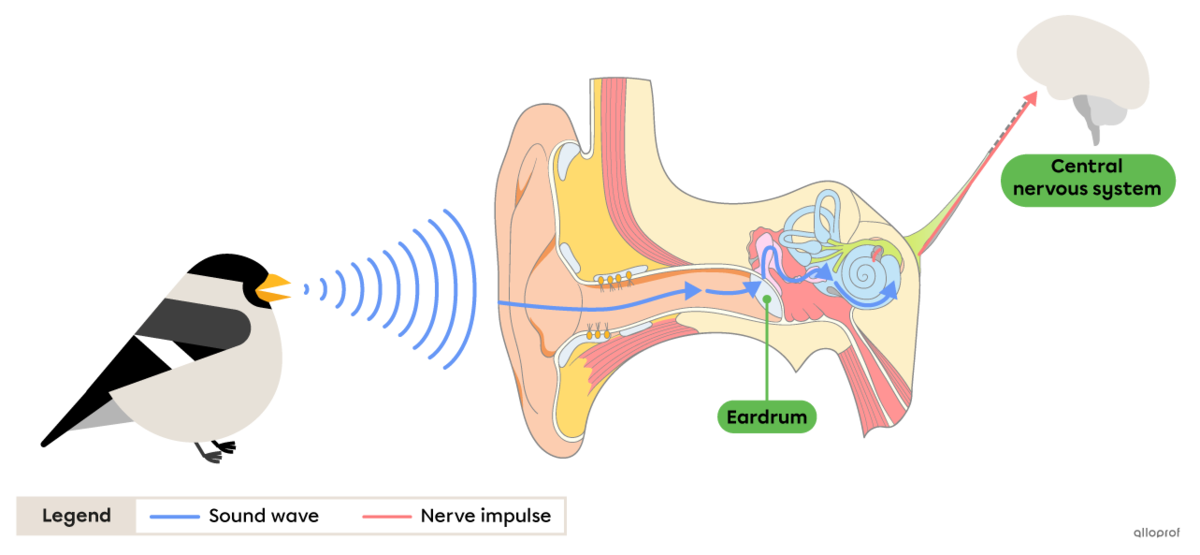
Perception of a sound due to the propagation of sound waves in the air
Be careful!
A mechanical wave cannot propagate in a vacuum, which is why sound cannot be heard in space.
Electromagnetic Waves
Some waves, called electromagnetic waves, can travel in a vacuum.
Electromagnetic waves do not need matter to propagate because they create disturbances in electric and magnetic fields.
Unlike mechanical waves, electromagnetic waves (EMW) do not need matter to propagate. These disturbances can propagate in a vacuum at a speed of approximately While they do not require matter to propagate, they interact with particles. For example, the Sun’s ultraviolet rays cause skin to tan or burn.
An electromagnetic wave is generally represented by a wavy line illustrating its characteristics, such as the wavelength and amplitude.
This type of diagram is commonly used to illustrate the electromagnetic spectrum, which is the grouping of all the types of electromagnetic waves based on their wavelength and frequency.
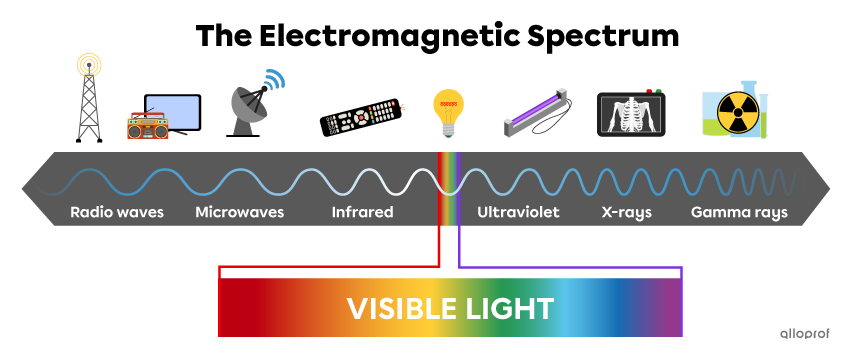
X-rays are electromagnetic waves that are used in medical imaging.

Skull X-ray
Puwadol Jaturawutthichai, Shutterstock.com
A star emits electromagnetic waves, including visible light, which travels through the vacuum of space and into Earth’s atmosphere.
Our eyes perceive these waves and gaze at the starlit sky.

Observing a starlit sky
Allexxandar, Shutterstock.com
Wave Classification According to Propagation Direction
The disturbance created by a wave can be perpendicular or parallel to the direction of the wave, meaning the wave can be either transverse or longitudinal.
Transverse Waves
The disturbance of the medium of a transverse wave is perpendicular to the direction of the wave.
Transverse waves can be mechanical or electromagnetic.
Important!
A transverse wave is mechanical when the particles of the propagation medium oscillate perpendicularly to the direction of the wave.
An ocean wave is a transverse mechanical wave.
As an ocean wave travels, it causes the water particles to oscillate vertically while the wave moves horizontally toward the coast in a direction perpendicular to the oscillation of the water particles.
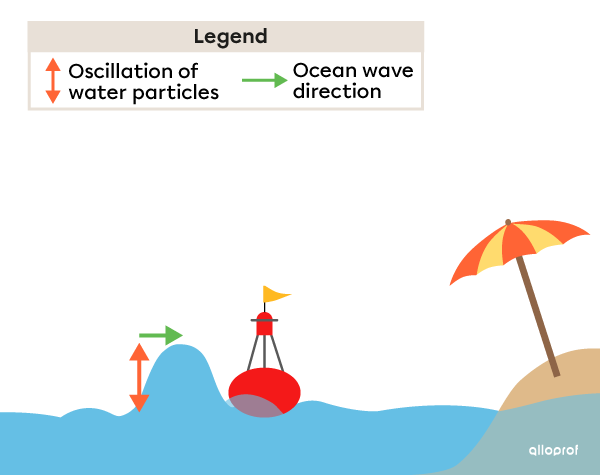
Position of a buoy before an ocean wave passes
The ocean wave causes the buoy to temporarily move up and down, indicating the vertical movement of the medium as the wave travels.
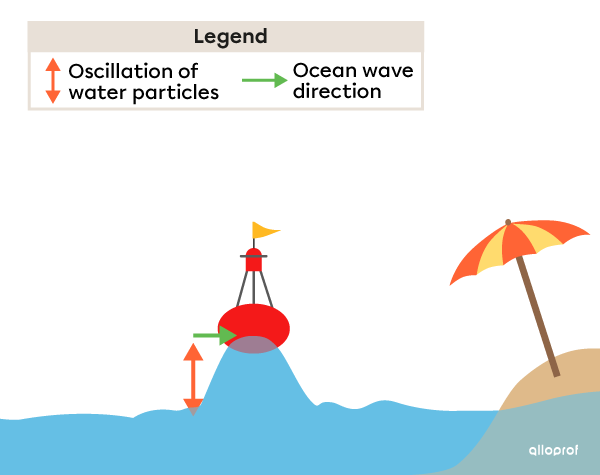
Position of a buoy as an ocean wave passes
The horizontal position of the buoy does not change when compared before, during and after the ocean wave passes, meaning there is no horizontal particle motion.
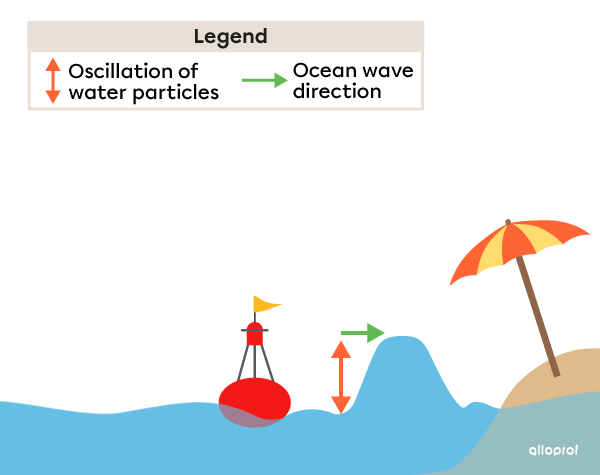
Position of a buoy after an ocean wave passes
Important!
An electromagnetic wave is always transverse.
Ultraviolet rays are electromagnetic waves and are therefore also transverse.
The energy carried by ultraviolet rays is used by plants during photosynthesis.

Romolo Tavani, Shutterstock.com
Longitudinal Waves
The disturbance of the medium of a longitudinal wave is parallel to the direction of the wave propagation.
Since electromagnetic waves are always transverse, only mechanical waves can be longitudinal.
When a spring is compressed and released, it generates a longitudinal wave.
The spring is positioned horizontally with one end secured and the other held by a hand. The spring is the wave’s propagation medium.
-
When the hand moves back and forth horizontally, the medium (the spring) is disturbed and temporarily compressed.
-
This disturbance is then transmitted horizontally along the spring.
Both the oscillation of the hand and the direction of the wave along the spring are horizontal. Since the movements are parallel, this is a longitudinal wave.

Propagation of a longitudinal wave in a spring
A sound wave is a longitudinal wave.
Sound is an oscillating motion between the particles of a medium. Since the particles oscillate in a direction parallel to the wave, it is a longitudinal wave.
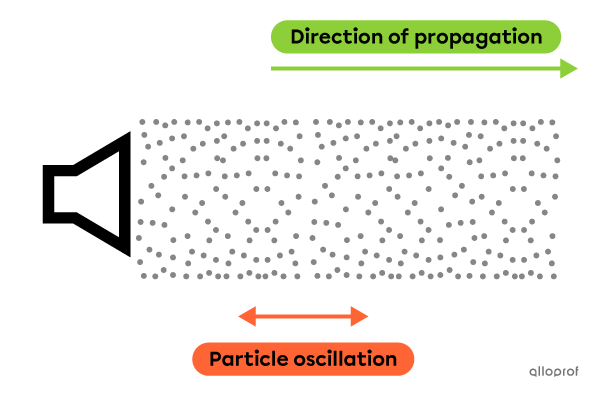
Particles oscillating during the propagation of a sound wave
